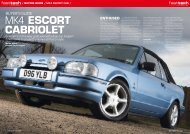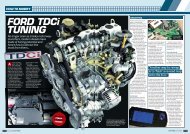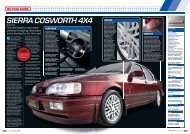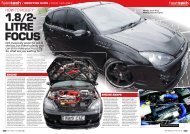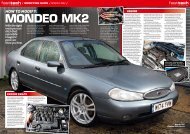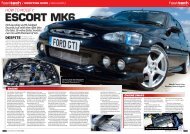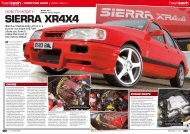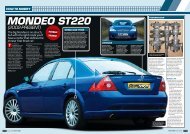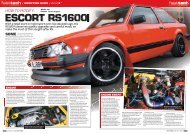You also want an ePaper? Increase the reach of your titles
YUMPU automatically turns print PDFs into web optimized ePapers that Google loves.
fasttech / BUYING GUIDE / <strong>ESCORT</strong> <strong>XR3</strong> & ’3i / fasttech<br />
CHECKLIST<br />
INTERIOR<br />
Basic, especially on <strong>XR3</strong>s, but the inside<br />
of the Escort is quite hard wearing if it<br />
has been treated with respect. After 20<br />
years though it’s inevitable that it will<br />
have seen some action.<br />
Usually it’s the seats that will show<br />
the biggest damage with sagging<br />
bolsters and torn cloth on the edges.<br />
Good, replacement second-hand ones<br />
are hard to find but it’s possible to buy<br />
a reproduction version of the early<br />
Laser fabric off the roll from some<br />
trim specialists.<br />
TRANSMISSION<br />
Little more than a beefed-up version<br />
of an early Fiesta box, the BC-type<br />
transmission, whether in four-speed<br />
or overdriven five-speed form, can still<br />
comfortably cope with the power of the<br />
<strong>XR3</strong> and <strong>XR3</strong>i.<br />
The fact that neither XR is particularly<br />
torquey helps to keep the box alive, but<br />
years of enthusiastic use are likely to<br />
have had some impact. Gear change<br />
quality was never the best, although<br />
the four-speed is considered to be the<br />
smoother shifting box, but a sloppy<br />
action indicates that the linkage is<br />
shot, while any crunching means<br />
the synchro is past its best.<br />
Generally, second and third<br />
gears lose synchro first. The<br />
clutch is a pretty puny 8 inch item<br />
so ensure it engages properly and check<br />
there’s no slippage by trying to pull away<br />
in third gear — it’s knackered if the XR<br />
doesn’t stall.<br />
Spring ’82-onwards cars<br />
came with five-speeder<br />
ENGINE IDENTITY<br />
In either injected or carburettor form the 1596cc engine is a<br />
reliable and willing performer. The CVH is more than capable of<br />
a six-figure mileage but only if it’s been well maintained with<br />
regular oil changes.<br />
The hydraulic lifters sludge up, killing the cam first and<br />
paving the way for accelerated engine wear — a rattle from<br />
the top end and blue smoke from oil being burnt in the<br />
combustion chambers are the obvious signs that the CVH<br />
is about to die. Look out for cambelt changes in the history<br />
too as if it goes west it’s not unusual for it to wipe out the<br />
whole engine.<br />
Both fuelling methods are reliable but think twice about a<br />
car that’s running a bit rough — the ‘3i’s K-Jetronic fuel<br />
injection is relatively simple but sorting out any problems is<br />
best left to the experts, while sound second-hand Weber DFTs<br />
carburettors are hard to find. Another thing to be aware of is<br />
that the distributors on <strong>XR3</strong>is suffer from weak springs,<br />
leading to full advance coming too early.<br />
The light coloured Monza trim and<br />
fleck door panels of later cars are prone<br />
to staining, but the biggest headache<br />
will be finding an XR with a crack-free<br />
dashboard. Over time, exposure to the<br />
sun causes the dash top to crack and as<br />
well as being a pain to replace it’s also<br />
costly — good, used dashes can change<br />
hands for upwards of £150.<br />
The plastic door bins of early <strong>XR3</strong>s are<br />
also prone to damage and tend to break<br />
off where they’re screwed into the door<br />
and onto the trim panel.<br />
Good trim’s all-important.<br />
As is a crack-free dash...<br />
Carb or fuel injection-fed,<br />
the 1.6 CVH is a good ’un<br />
BRAKES<br />
In relation to braking ability versus<br />
performance, the <strong>XR3</strong> and <strong>XR3</strong>i<br />
have the best brakes of a sporting<br />
MkIII Escort.<br />
Both XR models use a simple but<br />
effective disc/drum set-up (<strong>XR3</strong>i<br />
versions having slightly larger rear<br />
drums from the Escort van),<br />
which is<br />
Perhaps one of the most stolen cars ever, it’s<br />
essential to thoroughly check the car’s identity. The<br />
all-important numbers can be found in <strong>Ford</strong>’s favourite<br />
places — on the slam panel and under a flap in the<br />
carpet between the sill and driver’s seat. Look for iffy<br />
uneven numbers and signs of welding. Find out when<br />
the significant changes were made and see if they tally<br />
with the date of registration — five-speed box on a<br />
1980 <strong>XR3</strong>, then it’s a retro fit or something’s amiss...<br />
It may be 20-years-old, but you<br />
still need to check the VIN plate<br />
known to be largely reliable. As<br />
usual though, front discs are prone<br />
to warping — evident by judder<br />
through the steering wheel — and<br />
weeping rear cylinders, which are<br />
highlighted by brake fluid seeping<br />
onto the drum’s surface and an<br />
inefficient handbrake due to soaked<br />
brake shoes. The good news is that<br />
all brake components are dirt cheap<br />
and available from any decent<br />
motor factors.<br />
Dampers and springs take a<br />
beating: check each corner<br />
Unlike the Series 1, stock<br />
<strong>XR3</strong> brakes were plenty good<br />
Luxuries? This was all<br />
you got as standard!<br />
BODY<br />
Plenty have been written-off over the years but<br />
rust is the biggest killer of the XR. The MkIII shell<br />
can be a real rotter and with the earliest cars<br />
having just turned 25 years old, it’s rare to find an<br />
example that hasn’t got any grot.<br />
Prime spots are the chassis rails and battery<br />
tray, but check virtually everywhere including the<br />
inner wings, bulkhead, floorpan, sills and the<br />
boot floor. Genuine <strong>Ford</strong> panels are near extinct<br />
but it’s still possible to get repair sections,<br />
bumpers and some complete panels from a<br />
specialist like Hadrian.<br />
Reproduction decal kits are also available and<br />
there seems to be a good and steady supply of<br />
XR bodykit mouldings on eBay. These are<br />
generally cheap so it’s a good haggling point if<br />
the car you’re looking at is missing its rear spats<br />
or only has one section of the front spoiler. The<br />
Cloverleaf alloys also turn up regularly on eBay<br />
and don’t cost the earth.<br />
SUSPENSION<br />
ELECTRICS<br />
Not much to worry about really, the<br />
<strong>XR3</strong>’s only electrical luxury being a<br />
roof-mounted LED clock! Early<br />
<strong>XR3</strong>s with the optional fogs, central<br />
locking and electric windows are<br />
worth paying extra for so make<br />
sure that these are working<br />
correctly, if fitted. Don’t forget to<br />
check their operation on <strong>XR3</strong>is too,<br />
which featured much of this<br />
equipment as standard.<br />
Check out the underbonnet<br />
area, and look for frayed wiring<br />
and botched alarm installs — it’s<br />
not unusual to find an XR with<br />
an ancient non-operative alarm<br />
and immobiliser.<br />
The <strong>XR3</strong> and <strong>XR3</strong>i handle quite differently. The <strong>XR3</strong>’s spring rates<br />
make it superb on smooth surfaces but bumpy on anything else,<br />
while the <strong>XR3</strong>i is much more of an all-rounder, handling and<br />
riding well in all conditions.<br />
In standard trim a well-sprung early <strong>XR3</strong> will look slightly<br />
nose-up with the rear wheels showing a lot of negative camber<br />
and the fronts slightly bowed-in. In contrast, an <strong>XR3</strong>i will sit flat,<br />
an inch lower, and with no obvious wheel camber.<br />
Dampers and springs take a beating so bounce each corner<br />
of the car to check the rebound action and listen for any<br />
banging or clonking noises that could point to a snapped spring<br />
— especially if the car proves to be a handful under heavy<br />
braking and cornering.<br />
Check around the mounting points of the TCAs too as pre-<br />
1985 Escorts are known to suffer from the slightest of cracks in<br />
this area.<br />
0 1 5 2 FEBRUARY 2006 FAST FORD FAST FORD FEBRUARY 2006<br />
0 1 5 3




